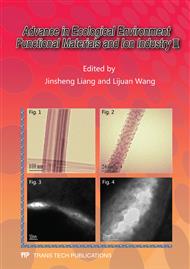p.128
p.133
p.139
p.143
p.148
p.153
p.157
p.163
p.169
Research Progress and Prospect of Inorganic Filler for Urea-Formaldehyde Resin Adhesive
Abstract:
The artificial plywood materials were prepared using natural minerals and inorganic oxide powders as the main fillers for urea-formaldehyde resin adhesive instead of flour. The method mentioned above has advantages in saving food resources, reducing cost of plywood, improving the quality of plywood and decreasing the release amount of free formaldehyde. On the basis of the research achievement both domestic, foreign and our experimental data, this paper mainly discussed the effect of filler on adhesive properties, bond strength of plywood, and free formaldehyde content, which provided reference for development of green environmental protection and low cost urea-formaldehyde resin adhesive minerals composite filler.
Info:
Periodical:
Pages:
148-152
Citation:
Online since:
January 2012
Authors:
Price:
Сopyright:
© 2012 Trans Tech Publications Ltd. All Rights Reserved
Share:
Citation:


